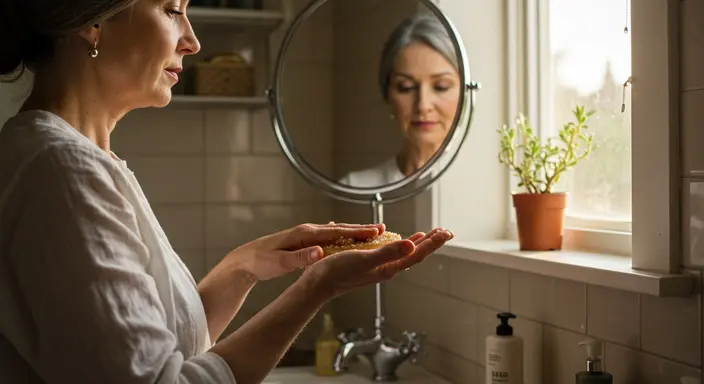Dealing with dark underarms can feel frustrating. You might feel self-conscious about raising your arms or wearing certain clothes. Know that you’re not alone in experiencing this skin concern.
“Hyperpigmentation in areas like the underarms is often harmless but can be a signal from your body. Treating it effectively means looking at both skincare and what’s happening beneath the surface.”
Dr. Whitney Bowe
Many people notice discoloration in their armpits at some point. The good news is that dark underarms are usually not a sign of anything serious. Often, simple changes or treatments can make a big difference.
You’ll learn what causes this darkening and explore various ways to address it. We want to help you understand your skin better and feel more comfortable.
Understanding Dark Underarms
So, what exactly are we talking about? Dark underarms refer to the skin in your armpit area appearing darker than your surrounding skin tone. This change in color is called hyperpigmentation.
Hyperpigmentation happens when your skin produces extra melanin, the pigment responsible for color in skin, hair, and eyes. Various factors can stimulate melanocytes, the pigment-producing cells, to become overactive in the underarm region. This leads to the visible darkening of the skin surface.
While it might bother you aesthetically, this condition itself isn’t typically harmful. But sometimes, it can be linked to an underlying condition or health issue. That’s why understanding the potential causes is helpful for finding the right approach.
Common Causes of Dark Underarms
Figuring out why your underarms are darkening is the first step toward finding a solution. Several factors can contribute, often working together. Let’s look at some common culprits behind this change in skin appearance.

Genetics and Skin Type
Sometimes, dark underarms simply run in the family. Your genetic makeup can predispose you to developing hyperpigmentation in certain areas, including the armpits. This trait is often more noticeable in individuals with naturally darker skin tones.
Certain skin types inherently have more active melanocytes. These pigment-producing cells can be more easily triggered by factors like irritation or hormonal shifts. Understanding your skin type can provide clues about your susceptibility.
Hormonal Changes
Hormones significantly influence skin pigmentation, impacting overall and
Insulin resistance is another crucial factor influencing glucose health. This condition, often associated with prediabetes or type 2 diabetes, can manifest various skin changes. One prominent change is acanthosis nigricans, presenting as dark, velvety patches commonly found in body folds like the armpits, according to the American Academy of Dermatology1.
Managing conditions linked to insulin resistance, like managing type 2 diabetes, is important not just for general health but also for addressing related skin issues. Monitoring blood sugar levels, possibly with at-home testing devices after consulting a doctor, plays a role. Attention to diabetes nutrition and overall metabolic health can sometimes improve skin presentation.
Medications
Certain medications might list skin darkening or hyperpigmentation as a potential side effect. High doses of niacin, pituitary extracts, systemic corticosteroids, and some birth control pills are occasionally implicated. These substances can influence hormone levels, inflammation, or skin cell production, contributing to changes in skin tone.
Other medications, such as those used for cancer care or managing conditions like bipolar disorder, can also have skin-related side effects. Always review potential side effects listed for your prescriptions. Using online resources like a pill identifier or consulting drugs a-z databases can offer initial information.
If you suspect a medication is causing your dark underarms, have a conversation with your doctor. Do not stop taking any prescribed medicine without professional medical guidance. Your doctor can help determine if the medication is the likely cause and discuss potential alternative treatments if necessary.
Deodorants and Antiperspirants
The products you apply daily could be contributing factors to underarm darkening. Some deodorants and antiperspirants contain ingredients like alcohol, baking soda, or strong fragrances. These components can irritate sensitive underarm skin, disrupting the natural barrier.
This irritation can lead to inflammation, a process known as contact dermatitis for some individuals. Over time, chronic inflammation might cause post-inflammatory hyperpigmentation (PIH), resulting in darker skin. Checking product reviews before buying can sometimes highlight potential irritants reported by other users.
Switching to a gentler, fragrance-free, and alcohol-free product could potentially help reduce irritation. Look for products formulated for sensitive skin. Considering options focused on natural ingredients might be beneficial, but always check for potential allergens2.
Shaving Habits
Shaving often causes underarm irritation. A dull razor, too much pressure, dry shaving, or shaving often can irritate sensitive skin. This irritation may boost melanin production, slowly darkening the skin over time.
Sometimes, dark skin might just be shadows from hair follicles beneath the surface. Shaving cuts hair bluntly at the skin’s surface. If you have dark or thick hair, it can make your skin look darker. This happens even if you don’t have much hyperpigmentation3.
To improve your shaving technique, use a sharp, multi-blade razor. Apply a moisturizing shaving cream or gel. Always shave in the direction of hair growth. Rinse the blade often and moisturize afterward to reduce irritation. You might want to try waxing or laser hair removal. They can give longer-lasting results and cause less irritation.
Friction
Constant friction from tight clothing can darken underarm skin. When fabric rubs against skin, it causes irritation and inflammation. Over time, this can lead to hyperpigmentation, especially in areas that rub frequently.
This problem can get worse during exercise or hot weather when you sweat. Wear looser clothes to reduce friction. Choose soft, breathable fabrics like cotton or linen. This change helps prevent further darkening and improves airflow to the skin.
Lack of Exfoliation
Your underarms need regular exfoliation, just like the rest of your body. Dead skin cells can build up in the armpit area, trapped by moisture and product residue. This buildup can make your skin look darker and duller.
Accumulated dead cells can also trap sweat, bacteria, and deodorant residues. This may lead to odor or irritation. Gentle exfoliation a few times a week can help remove this buildup and reveal brighter skin. However, don’t over-exfoliate. Too much scrubbing can cause irritation and worsen hyperpigmentation.
Obesity
Carrying extra weight is frequently associated with dark underarms. Obesity raises the risk of insulin resistance, so this link exists. Insulin resistance links closely to acanthosis nigricans. This skin condition shows up as dark, velvety patches.
Increased body weight also means more prominent skin folds. These folds can cause more skin rubbing together. This can trap more sweat in the underarm area. Both factors can cause skin irritation and may lead to darkening. This is noted in NIH health resources about insulin resistance and related conditions. Effective weight management can sometimes improve this condition.
To lose weight, focus on a balanced diet. Include healthy snacks and follow diabetes nutrition guidelines if needed. Regular physical activity, like walking, can also help with insulin resistance. Consulting resources like a nutrition edition guide may offer helpful strategies. Such lifestyle changes support overall wellness wellness.
Underlying Medical Conditions
Dark underarms are often harmless. However, they can sometimes indicate a medical issue that requires attention. The most common cause is acanthosis nigricans. This condition often occurs with diabetes, prediabetes, obesity, or hormonal disorders like PCOS4.
In some cases, sudden or unusual skin darkening can point to other problems. Thyroid issues, like hypothyroidism, and adrenal problems, like Addison’s disease, can change skin color. Inflammatory conditions, such as rheumatoid arthritis or psoriatic arthritis, can affect the skin. This happens due to systemic inflammation or certain medications. However, direct links to dark underarms are less common than hormonal causes.
Rarely, certain cancers can cause skin changes. If the darkening happens fast, is strong, or shows strange signs, see a professional.
Seeking medically reviewed information and consulting a healthcare professional is crucial for diagnosis. Addressing these underlying health conditions is essential.
How Can You Identify the Cause?
Finding the cause of dark underarms may take some careful thought. Start by looking at any recent changes in your routine or health. Did you switch deodorants, start a new medication, change your diet, or change how you remove hair?
Think about your health history and that of your family. Is there a history of diabetes, thyroid issues, PCOS, or hormonal problems? Have you experienced major weight changes? Have you noticed symptoms related to poor glucose health?
The best way to find the cause is to see a healthcare professional. A doctor or dermatologist can check your skin. They will look at the pattern of hyperpigmentation. They will take a detailed medical history and may order tests. This helps rule out or confirm any underlying conditions. You’ll get the right care based on solid medical knowledge and possibly featured in health news5.
Effective Treatments and Home Remedies for Dark Underarms
After you understand the likely cause, you can look into different treatment options. Solutions range from targeted medical interventions to simple adjustments and home remedies. Patience is key. It takes time to see visible improvements in skin tone.
Medical Treatments
If lifestyle changes and over-the-counter products don’t work, a dermatologist may suggest medical treatments. Prescription creams with retinoids, like tretinoin, are common. These vitamin A derivatives boost skin cell turnover. They can also lighten pigmentation over weeks or months.
Other prescription options include creams with hydroquinone, azelaic acid, or kojic acid. These ingredients block tyrosinase, an enzyme needed for melanin production. Use these only with a doctor’s guidance. They can cause irritation or even paradoxical darkening with hydroquinone.
In-office treatments offer stronger options. Chemical peels with glycolic, lactic, or salicylic acid can exfoliate deeply. They also help lighten the skin. Laser therapy effectively targets melanin. Different lasers break it down so the body can eliminate it. The American Society for Dermatologic Surgery explains how laser treatments help with pigmentation. Microneedling may also help by enhancing topical treatment absorption or boosting collagen.
These procedures are usually effective but can be costly. They might need several sessions for the best results. There are some risks. You may notice some redness, swelling, or dark spots if it’s not done correctly. Importantly, successful treatment also means addressing any underlying condition. Managing diabetes, treating hormonal issues like PCOS, and adjusting medications can help. With guidance, you can also reach weight goals. Over time, these steps can naturally reduce skin darkening.
Over-the-Counter Options
You can find helpful ingredients in over-the-counter (OTC) skin care products. Choose gentle exfoliants like alpha-hydroxy acids (AHAs). Glycolic acid and lactic acid are good options. Beta-hydroxy acids (BHAs), like salicylic acid, are also effective. These ingredients dissolve the bonds that hold dead skin cells together. This promotes shedding and reveals brighter skin.
Niacinamide, a form of Vitamin B3, is great for reducing inflammation. It improves the skin’s barrier and may lighten dark spots. Vitamin C serums protect the skin as antioxidants. They also brighten the skin tone over time. Try adding these to your routine slowly, starting a few times a week for best results.
Always use a gentle, fragrance-free moisturizer with exfoliating or brightening treatments. This keeps dark underarms skin moist. It supports the skin barrier and lowers irritation from active ingredients. Sun protection is crucial for the underarm area, especially if it’s exposed. This is important when using AHAs or retinoids, as they can make your skin more sensitive to the sun.
Natural Remedies (Use with Caution)
Some people like to try natural methods first. There isn’t much scientific proof for home remedies for dark underarms. Still, many people talk about them in wellness discussions. For example, potato slices or juice have an enzyme called catecholase. This enzyme is thought to lighten skin, but clinical evidence is mostly lacking.
Cucumber slices soothe and hydrate the skin. They have a high water content. This can feel nice on irritated skin. Aloe vera gel is well-liked for its soothing and hydrating effects. It’s a safe option for treating minor irritations. Turmeric paste, which uses curcumin’s anti-inflammatory benefits, is another traditional option. However, be careful, as turmeric can stain the skin yellow.
Lemon juice is often recommended because its citric acid acts as a natural AHA. But use it very cautiously. Undiluted lemon juice is very acidic. It can irritate the skin, cause burns, or make dark spots worse. This is especially true for sensitive dark underarms skin. It can also make skin more sensitive to sunlight, increasing the risk of sunburn.
Baking soda is often called a physical exfoliator. However, its high alkalinity can damage the skin’s natural barrier. This can lead to dryness, irritation, and long-term damage. Don’t put baking soda on your skin. This is especially true for sensitive spots like your dark underarms.
Always do a patch test before using any new remedy widely. Apply a small amount to a hidden area of skin, like the inner forearm. Wait 24 to 48 hours to check for redness, itching, or burning before using it on your dark underarms.
Lifestyle Changes and Prevention
To prevent dark underarms or stop them from worsening, make simple lifestyle changes. Focus on reducing irritation and tackling root causes like friction and metabolic factors. Consistency is key to success with these methods.
Keeping a healthy weight is important—not only for your overall well-being but also for reducing the risk of insulin resistance, a condition that can lead to acanthosis nigricans. To support a healthy weight, focus on eating a balanced diet rich in whole foods. Opt for nutritious, healthy snacks instead of processed ones to maintain energy and curb cravings.
Staying active is equally important. Regular exercise—even something as simple as a daily walking workout—can make a big difference. Physical activity, combined with proper nutrition, can improve your skin, heart health, sleep quality, and digestion by reducing inflammation.
For those looking for additional support in their weight management journey, you might explore how vitamin B12 can aid in weight loss as part of a well-rounded health strategy.
Be careful when picking daily hygiene products. If you suspect irritation, switch to gentle, alcohol-free, and fragrance-free deodorants or antiperspirants. Check ingredient lists for irritants like aluminum compounds, parabens, or harsh surfactants. You might find helpful insights in product reviews or safety databases.
Adjust your hair removal routine to protect your skin. If you shave, use a sharp, clean razor and a lubricating shaving cream or gel for sensitive skin. Shave gently in the direction of hair growth and avoid going over the same area too much. Consider gentler options like waxing, which removes hair from the root. You might also try laser hair removal for long-term reduction. Remember their costs and possible side effects. One example is temporary post-inflammatory hyperpigmentation (PIH).
Comparing Hair Removal Methods for Sensitive Dark Underarms
Choosing the right hair removal method can impact underarm skin health. Here’s a quick comparison:
| Method | Pros | Cons | Potential for PIH |
|---|---|---|---|
| Shaving | Quick, inexpensive, accessible. | Can cause irritation, razor burn, ingrown hairs; frequent upkeep needed. | Moderate, especially with improper technique or dull blades. |
| Waxing/Epilating | Longer-lasting results (weeks); hair may grow back finer. | Can be painful; risk of irritation, burns (wax), or ingrown hairs. | Moderate, especially if skin is pulled or wax is too hot. |
| Depilatory Creams | Painless; relatively quick. | Chemicals can cause irritation or allergic reactions; strong odor. | Low to Moderate, depends on skin sensitivity to chemicals. |
| Laser Hair Removal | Long-term hair reduction; can improve skin texture. | Expensive; requires multiple sessions; potential side effects (redness, swelling, pigment changes). | Low to Moderate, risk depends on laser type, technician skill, and skin tone (higher risk with darker skin if incorrect settings used). |
Opt for loose-fitting clothing whenever possible, particularly during exercise or hot weather. Choose garments made from natural, breathable fibers like cotton, linen, or bamboo.
This simple practice reduces friction on the delicate dark underarms skin. It also allows better air circulation, which prevents moisture buildup.
Incorporate gentle exfoliation into your weekly skin care routine. Aim for two or three times a week. Use a mild chemical exfoliant, like a low-concentration AHA or BHA wash. You can also use a soft washcloth with gentle pressure. Avoid harsh scrubs with large, jagged particles. Aggressive scrubbing can worsen irritation and darkening.
Don’t forget to moisturize the dark underarms area, especially after cleansing or exfoliating. Keeping the skin hydrated helps maintain a healthy barrier. Look for simple, fragrance-free moisturizers. Ingredients like ceramides or hyaluronic acid can support barrier function.
Impact on Mental Well-being
Dealing with dark underarms is more than just a cosmetic issue. It can affect your mental health and well-being. Feeling self-conscious about your underarms can make you skip certain clothes. You might avoid sleeveless tops or swimwear. This can hurt your social confidence and participation.
Worrying about skin appearance can cause anxiety or low self-esteem for some. It’s important to recognize these feelings. Remember, this is a common issue. Focusing on gentle care and addressing possible causes is a positive step.
If self-consciousness is hurting your life, talk to a friend or family member. You might also consider consulting a mental health professional. Exploring topics like self-acceptance and body positivity can help. Understanding the physiological reasons behind the condition can ease your distress.
When to See a Doctor
Dark underarms are usually not serious. You can treat them with lifestyle changes or over-the-counter products. However, it’s important to see a doctor or dermatologist in certain cases. Schedule an appointment if the darkening occurs suddenly or spreads quickly. These changes might signal a more serious underlying condition.
See a doctor if the dark patches get itchy, hurt, smell strange, or feel thick and velvety. These signs might show acanthosis nigricans. This condition may link to health problems like diabetes or hormonal issues.
If home treatments haven’t worked for weeks or months, seek a professional evaluation. A doctor or dermatologist can diagnose your condition. They can rule out serious problems. Then, they can suggest the right prescription treatments for you. Before your appointment, write down your symptoms, timelines, and the products you use. This will help you have a productive consultation. It might also include health news or reports you’ve read.
Conclusion
Dark underarms are a common skin issue and usually not a major concern. Understanding triggers is key. These can be caused by friction, product irritation, hormonal changes, or health issues like acanthosis nigricans. Knowing these factors is the first step to finding relief. Many treatments and prevention strategies can lighten your skin. They can also boost your confidence over time.
Be patient with treatment, as results can take weeks or months to appear. Use gentle skin care and make lifestyle changes to reduce irritation. Focus on managing factors like weight and glucose levels. These steps, along with targeted treatments, can lead to positive changes. For more information, check reliable resources like Healthline Media or wellness topics.
If you’re still concerned about your dark underarms, or if the darkening doesn’t get better at home, talk to a doctor. A doctor or dermatologist can diagnose the problem. They can recommend ways to treat dark underarms. This can also boost your health and mental well-being.
Small Step, Big Impact
Maintaining a healthy lifestyle, including a balanced diet and regular exercise, can significantly reduce the risk of conditions like acanthosis nigricans, leading to healthier and more even-toned underarms.
Listen to this article
This is an AI generated Podcast version of the article.
- https://www.aad.org/public/diseases/a-z/acanthosis-nigricans-causes[↩]
- https://www.linkedin.com/pulse/fragrance-free-vs-hypoallergenic-what-matters-most-sensitive-1i31e[↩]
- https://estrid.com/blogs/shaving-tricks/does-shaving-or-waxing-make-your-hair-grow-thicker-quicker-and-darker[↩]
- https://www.mayoclinic.org/diseases-conditions/acanthosis-nigricans/symptoms-causes/syc-20368983[↩]
- https://www.medicalnewstoday.com/articles/323808[↩]



